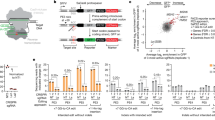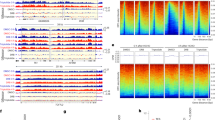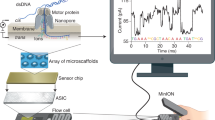Abstract
We have determined the solution structure of the complex between an arginine-glycine-rich RGG peptide from the human fragile X mental retardation protein (FMRP) and an in vitro–selected guanine-rich (G-rich) sc1 RNA. The bound RNA forms a newly discovered G-quadruplex separated from the flanking duplex stem by a mixed junctional tetrad. The RGG peptide is positioned along the major groove of the RNA duplex, with the G-quadruplex forcing a sharp turn of R10GGGGR15 at the duplex-quadruplex junction. Arg10 and Arg15 form cross-strand specificity–determining intermolecular hydrogen bonds with the major-groove edges of guanines of adjacent Watson-Crick G•C pairs. Filter-binding assays on RNA and peptide mutations identify and validate contributions of peptide-RNA intermolecular contacts and shape complementarity to molecular recognition. These findings on FMRP RGG domain recognition by a combination of G-quadruplex and surrounding RNA sequences have implications for the recognition of other genomic G-rich RNAs.
This is a preview of subscription content, access via your institution
Access options
Subscribe to this journal
Receive 12 print issues and online access
$189.00 per year
only $15.75 per issue
Buy this article
- Purchase on Springer Link
- Instant access to full article PDF
Prices may be subject to local taxes which are calculated during checkout







Similar content being viewed by others
Accession codes
References
Huppert, J.L. & Balasubramanian, S. Prevalence of quadruplexes in the human genome. Nucleic Acids Res. 33, 2908–2916 (2005).
Todd, A.K., Johnston, M. & Neidle, S. Highly prevalent putative quadruplex sequence motifs in human DNA. Nucleic Acids Res. 33, 2901–2907 (2005).
Kumari, S., Bugaut, A., Huppert, J.L. & Balasubramanian, S. An RNA G-quadruplex in the 5′ UTR of the NRAS proto-oncogene modulates translation. Nat. Chem. Biol. 3, 218–221 (2007).
Saxena, S., Miyoshi, D. & Sugimoto, N. Sole and stable RNA duplexes of G-rich sequences located in the 5′-untranslated region of protooncogenes. Biochemistry 49, 7190–7201 (2010).
Bonnal, S. et al. A single internal ribosome entry site containing a G quartet RNA structure drives fibroblast growth factor 2 gene expression at four alternative translation initiation codons. J. Biol. Chem. 278, 39330–39336 (2003).
Oliver, A.W., Bogdarina, I., Schroeder, E., Taylor, I.A. & Kneale, G.G. Preferential binding of fd gene 5 protein to tetraplex nucleic acid structures. J. Mol. Biol. 301, 575–584 (2000).
Arora, A. et al. Inhibition of translation in living eukaryotic cells by an RNA G-quadruplex motif. RNA 14, 1290–1296 (2008).
Bensaid, M. et al. FRAXE-associated mental retardation protein (FMR2) is an RNA-binding protein with high affinity for G-quartet RNA forming structure. Nucleic Acids Res. 37, 1269–1279 (2009).
Didiot, M.C. et al. The G-quartet containing FMRP binding site in FMR1 mRNA is a potent exonic splicing enhancer. Nucleic Acids Res. 36, 4902–4912 (2008).
Huppert, J.L., Bugaut, A., Kumari, S. & Balasubramanian, S. G-quadruplexes: the beginning and end of UTRs. Nucleic Acids Res. 36, 6260–6268 (2008).
Bagga, P.S., Ford, L.P., Chen, F. & Wilusz, J. The G-rich auxiliary downstream element has distinct sequence and position requirements and mediates efficient 3′ end pre-mRNA processing through a trans-acting factor. Nucleic Acids Res. 23, 1625–1631 (1995).
Darnell, J.C. et al. Fragile X mental retardation protein targets G quartet mRNAs important for neuronal function. Cell 107, 489–499 (2001).
Schaeffer, C. et al. The fragile X mental retardation protein binds specifically to its mRNA via a purine quartet motif. EMBO J. 20, 4803–4813 (2001).
Bassell, G.J. & Warren, S.T. Fragile X syndrome: loss of local mRNA regulation alters synaptic development and function. Neuron 60, 201–214 (2008).
De Boulle, K. et al. A point mutation in the FMR-1 gene associated with fragile X mental retardation. Nat. Genet. 3, 31–35 (1993).
Zang, J.B. et al. A mouse model of the human Fragile X syndrome I304N mutation. PLoS Genet. 5, e1000758 (2009).
Darnell, J.C., Fraser, C.E., Mostovetsky, O. & Darnell, R.B. Discrimination of common and unique RNA-binding activities among Fragile X mental retardation protein paralogs. Hum. Mol. Genet. 18, 3164–3177 (2009).
Phan, A.T. & Patel, D.J. A site-specific low-enrichment (15)N,(13)C isotope-labeling approach to unambiguous NMR spectral assignments in nucleic acids. J. Am. Chem. Soc. 124, 1160–1161 (2002).
Phan, A.T. Long-range imino proton-13C J-couplings and the through-bond correlation of imino and non-exchangeable protons in unlabeled DNA. J. Biomol. NMR 16, 175–178 (2000).
Martadinata, H. & Phan, A.T. Structure of propeller-type parallel-stranded RNA G-quadruplexes, formed by human telomeric RNA sequences in K+ solution. J. Am. Chem. Soc. 131, 2570–2578 (2009).
Fiala, R., Jiang, F. & Sklenar, V. Sensitivity optimized HCN and HCNCH experiments for 13C/15N labeled oligonucleotides. J. Biomol. NMR 12, 373–383 (1998).
Nikonowicz, E.P. & Pardi, A. An efficient procedure for assignment of the proton, carbon and nitrogen resonances in 13C/15N labeled nucleic acids. J. Mol. Biol. 232, 1141–1156 (1993).
Dingley, J.C. & Grzesiek, S. Direct observation of hydrogen bonds in nucleic acid base pairs by internucleotide 2JNN couplings. J. Am. Chem. Soc. 120, 8293–8297 (1998).
Pervushin, K. et al. NMR scalar couplings across Watson-Crick base pair hydrogen bonds in DNA observed by transverse relaxation-optimized spectroscopy. Proc. Natl. Acad. Sci. USA 95, 14147–14151 (1998).
Majumdar, A., Kettani, A., Skripkin, E. & Patel, D. Observation of internucleotide NH.N hydrogen bonds in the absence of directly detectable protons. J. Biomol. NMR 15, 207–211 (1999).
Majumdar, A., Kettani, A. & Skripkin, E. Observation and measurement of internucleotide 2JNN coupling constants between 15N nuclei with widely separated chemical shifts. J. Biomol. NMR 14, 67–70 (1999).
Muhandiram, R. & Kay, L.E. Gradient-enhanced triple-resonance three-dimensional NMR experiments with improved sensitivity. J. Magn. Reson. B. 103, 203–216 (1994).
Clore, G.M. & Gronenborn, A.M. Multidimensional heteronuclear nuclear magnetic resonance of proteins. Methods Enzymol. 239, 349–363 (1994).
Lunde, B.M., Moore, C. & Varani, G. RNA-binding proteins: modular design for efficient function. Nat. Rev. Mol. Cell Biol. 8, 479–490 (2007).
Majumdar, A., Gosser, Y. & Patel, D.J. 1H–1H correlations across N-H...N hydrogen bonds in nucleic acids. J. Biomol. NMR 21, 289–306 (2001).
Parkinson, G.N., Lee, M.P. & Neidle, S. Crystal structure of parallel quadruplexes from human telomeric DNA. Nature 417, 876–880 (2002).
Phan, A.T., Modi, Y.S. & Patel, D.J. Propeller-type parallel-stranded G-quadruplexes in the human c-myc promoter. J. Am. Chem. Soc. 126, 8710–8716 (2004).
Patel, D.J., Phan, A.T. & Kuryavyi, V. Human telomere, oncogenic promoter and 5′-UTR G-quadruplexes: diverse higher order DNA and RNA targets for cancer therapeutics. Nucleic Acids Res. 35, 7429–7455 (2007).
Ramos, A., Hollingworth, D. & Pastore, A. G-quartet-dependent recognition between the FMRP RGG box and RNA. RNA 9, 1198–1207 (2003).
Zanotti, K.J., Lackey, P.E., Evans, G.L. & Mihailescu, M.R. Thermodynamics of the fragile X mental retardation protein RGG box interactions with G quartet forming RNA. Biochemistry 45, 8319–8330 (2006).
Blackwell, E., Zhang, X. & Ceman, S. Arginines of the RGG box regulate FMRP association with polyribosomes and mRNA. Hum. Mol. Genet. 19, 1314–1323 (2010).
Cate, J.H. et al. RNA tertiary structure mediation by adenosine platforms. Science 273, 1696–1699 (1996).
Puglisi, J.D., Chen, L., Blanchard, S. & Frankel, A.D. Solution structure of a bovine immunodeficiency virus Tat-TAR peptide-RNA complex. Science 270, 1200–1203 (1995).
Ye, X., Kumar, R.A. & Patel, D.J. Molecular recognition in the bovine immunodeficiency virus Tat peptide-TAR RNA complex. Chem. Biol. 2, 827–840 (1995).
Davidson, A. et al. Simultaneous recognition of HIV-1 TAR RNA bulge and loop sequences by cyclic peptide mimics of Tat protein. Proc. Natl. Acad. Sci. USA 106, 11931–11936 (2009).
Licatalosi, D.D. & Darnell, R.B. Splicing regulation in neurologic disease. Neuron 52, 93–101 (2006).
Cooper, T.A., Wan, L. & Dreyfuss, G. RNA and disease. Cell 136, 777–793 (2009).
Ota, T. et al. Complete sequencing and characterization of 21,243 full-length human cDNAs. Nat. Genet. 36, 40–45 (2004).
Vaccari, T. et al. The human gene coding for HCN2, a pacemaker channel of the heart. Biochim. Biophys. Acta 1446, 419–425 (1999).
Wang, C. & Meier, U.T. Architecture and assembly of mammalian H/ACA small nucleolar and telomerase ribonucleoproteins. EMBO J. 23, 1857–1867 (2004).
Vanhalst, K., Kools, P., Staes, K., van Roy, F. & Redies, C. delta-Protocadherins: a gene family expressed differentially in the mouse brain. Cell. Mol. Life Sci. 62, 1247–1259 (2005).
Gerdes, D., Wehling, M., Leube, B. & Falkenstein, E. Cloning and tissue expression of two putative steroid membrane receptors. Biol. Chem. 379, 907–911 (1998).
Katoh, K. et al. The ALG-2-interacting protein Alix associates with CHMP4b, a human homologue of yeast Snf7 that is involved in multivesicular body sorting. J. Biol. Chem. 278, 39104–39113 (2003).
Hanakahi, L.A., Sun, H. & Maizels, N. High affinity interactions of nucleolin with G-G-paired rDNA. J. Biol. Chem. 274, 15908–15912 (1999).
Mazroui, R. et al. Trapping of messenger RNA by Fragile X Mental Retardation protein into cytoplasmic granules induces translation repression. Hum. Mol. Genet. 11, 3007–3017 (2002).
Stetler, A. et al. Identification and characterization of the methyl arginines in the fragile X mental retardation protein Fmrp. Hum. Mol. Genet. 15, 87–96 (2006).
Pfeiffer, B.E. et al. Fragile X mental retardation protein is required for synapse elimination by the activity-dependent transcription factor MEF2. Neuron 66, 191–197 (2010).
Batey, R.T., Battiste, J.L. & Williamson, J.R. Preparation of isotopically enriched RNAs for heteronuclear NMR. Methods Enzymol. 261, 300–322 (1995).
Pikovskaya, O., Serganov, A.A., Polonskaia, A., Serganov, A. & Patel, D.J. Preparation and crystallization of riboswitch-ligand complexes. Methods Mol. Biol. 540, 115–128 (2009).
Kuryavyi, V. & Patel, D.J. Solution structure of a unique G-quadruplex scaffold adopted by a guanosine-rich human intronic sequence. Structure 18, 73–82 (2010).
Brown, V. et al. Microarray identification of FMRP-associated brain mRNAs and altered mRNA translational profiles in fragile X syndrome. Cell 107, 477–487 (2001).
Acknowledgements
We thank Y. Gosser and S. Pitt (Memorial Sloan-Kettering Cancer Center) for their participation at the early stage of the project, O. Mostovetsky, E.F. Stone and K.Y.S. Hung (Rockefeller University) for technical assistance, and A. Lash (Memorial Sloan-Kettering Cancer Center) for bioinformatics of the RG4R motif in the human genome. This research was supported by US National Institutes of Health grants CA049982 (to D.J.P.) and R01 HD040647 (to J.C.D.) and Singapore Biomedical Research Council grant 07/1/22/19/542 to A.T.P. D.J.P. is a member of the New York Structural Biology Center, supported by US National Institutes of Health grant GM66354.
Author information
Authors and Affiliations
Contributions
A.T.P., A.M. and S.I. were responsible for NMR studies, V.K. undertook the computations, and A.S., T.R. and A.P. prepared labeled NMR samples, all under the supervision of D.J.P. C.C., D.C. and J.C.D. did the filter-binding assays under the joint supervision of J.C.D. and R.B.D. The paper was written jointly by D.J.P., A.T.P., V.K., J.C.D. and R.B.D.
Corresponding authors
Ethics declarations
Competing interests
The authors declare no competing financial interests.
Supplementary information
Supplementary Text and Figures
Supplementary Figures 1–9, Supplementary Tables 1–3, Supplementary Discussion and Supplementary Methods (PDF 9510 kb)
Rights and permissions
About this article
Cite this article
Phan, A., Kuryavyi, V., Darnell, J. et al. Structure-function studies of FMRP RGG peptide recognition of an RNA duplex-quadruplex junction. Nat Struct Mol Biol 18, 796–804 (2011). https://doi.org/10.1038/nsmb.2064
Received:
Accepted:
Published:
Issue Date:
DOI: https://doi.org/10.1038/nsmb.2064
This article is cited by
-
RHAU Peptides Specific for Parallel G-Quadruplexes: Potential Applications in Chemical Biology
Molecular Biotechnology (2023)
-
G4-quadruplex-binding proteins: review and insights into selectivity
Biophysical Reviews (2022)
-
Function of FMRP Domains in Regulating Distinct Roles of Neuronal Protein Synthesis
Molecular Neurobiology (2022)
-
The structural basis for RNA selectivity by the IMP family of RNA-binding proteins
Nature Communications (2019)
-
CAPRI enables comparison of evolutionarily conserved RNA interacting regions
Nature Communications (2019)



